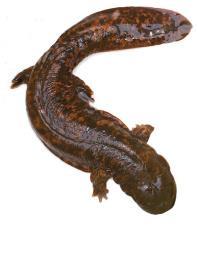
Not ‘Hellraiser’, FFS – ‘hellbender’
Here’s one by my new PhD student, Leah Collett:
–
I have never heard of the hellbender before. “Brilliant name”, I thought. Then I saw it mentioned again a few days later, in company with honey badgers and blue-footed boobies, in a recent article on why we need to see nature as useless in order to ‘save’ it.
So what is it? The hellbender is a species of salamander found in eastern North America, the only species of its genus it turns out, and one of only three left in its family (Cryptobranchidae – ‘hidden gills’). It is assessed as Near Threatened with possible extinction in the near future by the IUCN Red List. Along with the, sadly all too often, habitat degradation it is suffering due to it being highly sensitive to environmental change, it is still believed to be poisonous and that it will kill other fish and their eggs with this poison. In this day and age, some people will kill these salamanders when they come across them when they are out fishing, due to inaccurate held beliefs. I think I found it more incredible that this still occurs in a country where people have quick access to research and information denouncing such a myth.
This wonderful document on the biology and ecology of the hellbenders includes a section titled ‘Man and Hellbenders’ and highlights the likely culprit for starting the ‘hellbenders are poisonous – kill them all’ campaign:
“Dr N. Bayard Green (1971) related how a former editor of the Pocahontas Times (Pocahontas, West Virginia) in 1926 continually tried to vilify the hellbender as a destroyer of game fish and their eggs. Throughout West Virginia many sportsmen’s groups attempted to eradicate many of the so-called enemies of fish and game.”
(I could not read the original paper of Dr Green’s, although it might be available in the collections section).
 Indeed, studies in 1933 and 1935 found no evidence of hellbenders eating trout eggs, nor were they believed to be bad for game fish. Two papers in 1955 and 1971 noted that the skin secretions might be toxic only when injected to white mice, and that hellbender are repulsive to human taste (cheers to that man for trying them out in the name of science!).
Indeed, studies in 1933 and 1935 found no evidence of hellbenders eating trout eggs, nor were they believed to be bad for game fish. Two papers in 1955 and 1971 noted that the skin secretions might be toxic only when injected to white mice, and that hellbender are repulsive to human taste (cheers to that man for trying them out in the name of science!).
If fishermen hooked a hellbender on the end of their line, they used to cut it and throw-away the line to save themselves from having to touch the ‘exceedingly poisonous…revolting figure’. Today, the State Virginia Department of Game and Inland Fisheries webpage on the eastern hellbender advises fishermen that the species is of no threat to humans, and they are advised if they do catch one, to cut the line close to the mouth, remove the hook and release it back into the water. Under the State’s Wildlife Action Plan, the species is of special concern and cannot be sold, killed or kept for personal use.
The slimy mucus salamanders produce are thought to keep the skin moist, help against bacterial infections, reduce friction when swimming and make the animal slippery to potential predators. There is a North American newt that does produce toxins that are poisonous to predators and strong enough to kill a man silly enough to swallow one on a dare; however, they are found in the west of North America, and so not likely to be confused with this amphibian, and I have come across no literature relating to misidentification. It seems the hellbender is still killed today due to old fashioned, inaccurate beliefs, and it is an added threat it could do without.

